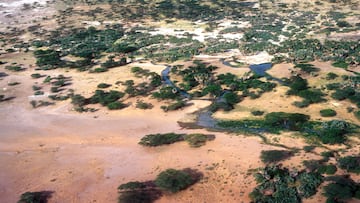Is Africa splitting into two continents? The geographical phenomenon explained
Photos appear to show evidence of giant cracks forming in parts of Kenya and Ethiopa, but they are not quite what they seem.

Images from the Kenyan Rift Valley purporting to show evidence of a continental split that could see Africa divided into two have circulated online. A large crack in the ground has been cited as proof that tectonic movements are wrenching the continent apart and could see the landmass divided into two.
Reports are also claiming that a massive 35-mile split in the Ethiopian desert is further evidence of the trend, but the dramatic images are not what they seem.
The cracks in the ground are the result of much more localised events. The Guardian reports that the geological features are much more likely to have been caused by sudden erosion, rather than a cross-continental tectonic movement.
However, it is true that the continent of Africa is gradually being split in half as tectonic plates far below the surface slowly shift.
What is a rift valley?
The activity responsible for the changing face of the continents is a process known as plate tectonics, whereby the vast tectonic plates beneath the earth’s surface grind together and move apart. Tectonic activity is responsible for phenomena like earthquakes and volcanoes, and it tends to be concentrated around specific areas.
The term ‘rift valley’ is used to describe spots where tectonic plates are gradually moving further apart. This movement leaves a gulley in the gap left behind, sometimes forming deep cracks. This was, incorrectly, cited as the cause of cracks seen in Africa.
Researchers believe that tectonic movement below Africa will eventually see the continent divided in two, along the Great Rift Valley system. This line stretches from southwestern Asia to the Horn of Africa, comprised of a series of fault lines.
This could see the area around Somali sheered off from the rest of the continent and the seafloor spread into the resultant void.
What caused the cracks in Kenya?
Kenya experiences some of the most extreme changes of climate anywhere on the planet. Sustained periods of hot, dry weather give way to sudden bursts of heavy rainfall and the region can be susceptible to both draughts and floods.
Shortly before the crack was first identified there was a spell of heavy rain that could well have eroded the extremely dry soil closest to the surface. With such a large volume of water falling in such a short period this could have created grooves in the surface that quickly grew deeper as the rainwater flowed.
Studies have also suggested that areas around major fault lines are more likely to experience erosion in this way, due to the higher-than-usual concentration of volcanic ash deposited in the soil.






